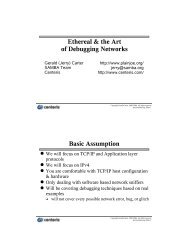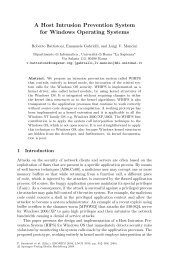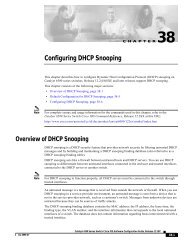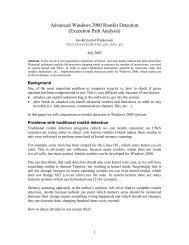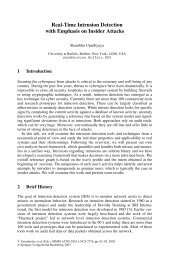Economic aspects of information security - Craig Chamberlain
Economic aspects of information security - Craig Chamberlain
Economic aspects of information security - Craig Chamberlain
- No tags were found...
You also want an ePaper? Increase the reach of your titles
YUMPU automatically turns print PDFs into web optimized ePapers that Google loves.
Inf Syst Front (2006) 8:335–337DOI 10.1007/s10796-006-9010-7<strong>Economic</strong> <strong>aspects</strong> <strong>of</strong> <strong>information</strong> <strong>security</strong>: An emergingfield <strong>of</strong> researchLawrence A. Gordon & Martin P. LoebPublished online: 23 December 2006# Springer Science + Business Media, LLC 2006Abstract This paper chronicles the development <strong>of</strong> economics<strong>of</strong> <strong>information</strong> <strong>security</strong> as an academic area <strong>of</strong>research. It also describes the contributions <strong>of</strong> the papers inthe special section <strong>of</strong> this issue devoted to the topic.Keywords Information <strong>security</strong>. <strong>Economic</strong> aspect .Security cost1 IntroductionBy the end <strong>of</strong> the 1990s, the Internet was already part <strong>of</strong>everyday life and the popular media featured stories oncomputer viruses and <strong>information</strong> <strong>security</strong> breaches. Withthis backdrop and our longstanding interests in economicmodeling and analysis <strong>of</strong> managerial accounting topicssuch as capital budgeting and incentive compensation, webegan to explore the area <strong>of</strong> <strong>information</strong> <strong>security</strong>. Our initialfocus was on the following three related research questions:(1) how much should an organization spend on <strong>information</strong><strong>security</strong>, (2) how should an organization allocate their<strong>information</strong> <strong>security</strong> budget to specific <strong>security</strong> activities,L. A. Gordon (*) : M. P. LoebUniversity <strong>of</strong> Maryland Institute for Advanced Computer Studies,Robert H. Smith School <strong>of</strong> Business,3351 Van Munching Hall,University <strong>of</strong> Maryland,College Park, MD 20742-1815, USAe-mail: lgordon@rhsmith.umd.eduM. P. Loebe-mail: mloeb@rhsmith.umd.eduand (3) what is the economic cost <strong>of</strong> <strong>information</strong> <strong>security</strong>breaches? As we began our research related to these issues,we were surprised to find the paucity <strong>of</strong> academic literatureapplying or developing rigorous economic analysis toproblems <strong>of</strong> <strong>information</strong> <strong>security</strong>. There was, however, anincreasing realization among both computer <strong>security</strong> pr<strong>of</strong>essionalsand academicians that the provision <strong>of</strong> effective<strong>information</strong> <strong>security</strong> requires attention to economic incentivesin conjunction with technical solutions (such as theimproved firewalls and intrusion detection systems).In late 2001, while our initial paper (Gordon & Loeb,2002) addressing <strong>information</strong> <strong>security</strong> investments wasunder review, we became aware <strong>of</strong> a then recent conferencepaper by Ross Anderson, a <strong>security</strong> engineering pr<strong>of</strong>essorat Cambridge University. That paper, by Anderson (2001),lucidly explains the crucial role economic incentives play inthe computer <strong>security</strong> arena. We soon got in touch withRoss and he invited us to join himself, noted economist HalVarian and five other distinguished scholars (L. Jean Camp,Li Gong, Andrew Odlyzko, Bruce Schneier, and DougTygar) to form the Program Committee organizing the firstWorkshop on <strong>Economic</strong>s and Information Security (WEIS).Ross and Hal served as program co-chairs for that firstWEIS held at Berkeley in May <strong>of</strong> 2002. 1 The Workshop,for the first time, brought together scholars and <strong>security</strong>pr<strong>of</strong>essionals with diverse backgrounds, but with a commoninterest in economic <strong>aspects</strong> associated with <strong>information</strong>and computer <strong>security</strong>. Among the topics covered by1 The agenda for WEIS 2002 (and links to papers) can be found at:http://www.sims.berkeley.edu:8000/resources/affiliates/workshops/econ<strong>security</strong>/
336 Inf Syst Front (2006) 8:335–3372 The agenda for WEIS 2003 (and links to the papers) can be found at:http://www.cpppe.umd.edu/rhsmith3/agenda.htm3 The agenda for WEIS 2004 (and links to the papers) can be found at:http://www.dtc.umn.edu/weis2004/agenda.html4 The agenda for WEIS 2005 (and links to the papers) can be found athttp://infosecon.net/workshop/schedule.php5 The agenda for WEIS 2006 (and links to the papers) can be found at:http://weis2006.econinfosec.org/prog.html6 The agenda for WEIS 2006 (and links to the papers) can be found at:http://wesii.econinfosec.org/workshop/program.phppresentations at this first workshop were liability, cyberinsurance, <strong>information</strong> <strong>security</strong> investments, externalities,<strong>security</strong> metrics, free-riding, price discrimination, privacy,<strong>information</strong> sharing and incentive compatibility. In additionto presentations by the Program Committee membersAnderson, Camp, Odlyzko, Schneier, and ourselves (togetherwith Bill Lucyshyn), the program featured separatepresentations by two doctoral students, Alessandro Acquistiand Stuart Schechter who would join the WEIS ProgramCommittee in years to come.The second WEIS was held in 2003 at the University <strong>of</strong>Maryland, and we had the pleasure to host that event. The hottopic <strong>of</strong> the time was Micros<strong>of</strong>t’s trusted computinginitiative, and the workshop included a presentation by asenior executive from Micros<strong>of</strong>t, as well as scholarly paperson the topic. 2 The 2004 WEIS was hosted by AndrewOdlyzko and Bruce Schneier at the University <strong>of</strong> Minnesota’sDigital Technology Center. 3 The 2005 WEIS was heldat Harvard’s Kennedy School and hosted by L. Jean Camp 4and the 2006 WEIS was held at Cambridge University andwas hosted by Ross Anderson. 5 The 2007 WEIS isscheduled to be held at Carnegie Mellon (and hosted byAlessandro Acquisti and Rahul Telang).In addition to the establishment and growth <strong>of</strong> WEIS,there are other indicators <strong>of</strong> the increased interest in researchon economic <strong>aspects</strong> <strong>of</strong> <strong>information</strong> <strong>security</strong>. Publication <strong>of</strong> acollection <strong>of</strong> papers in book form, Camp and Lewis (2004),is another indication, as is the publication by McGraw-Hill<strong>of</strong> our own book, Gordon and Loeb (2006). Moreover, forthree consecutive years, we, together with Bill Lucyshyn,have organized a one one-day forum on “FinancialInformation Systems and Cyber<strong>security</strong>: A Public PolicyPerspective” that we hold at the University <strong>of</strong> Maryland.Finally, we note that the first Workshop on the <strong>Economic</strong>s<strong>of</strong> Securing the Information Infrastructure (WESII) washeld in Arlington, Virginia in October 2006. 6The three papers in this Special Section are representative<strong>of</strong> the variety <strong>of</strong> research being done in the emergingarea <strong>of</strong> <strong>information</strong> <strong>security</strong> economics. The first paper inthis section, Hausken (2006), uses economic modeling toassess the relation between the optimal level <strong>of</strong> <strong>information</strong><strong>security</strong> investment and the vulnerability <strong>of</strong> an <strong>information</strong>set under differing returns scenarios. The analysis representsboth a robustness check and an extension <strong>of</strong> the earlyGordon and Loeb (2002) <strong>information</strong> <strong>security</strong> model.Hausken (2006) makes the case that the probability <strong>of</strong> an<strong>information</strong> <strong>security</strong> breach, similar to various otherphenomenon, is best modeled using a logistic function thatexhibits increasing returns and then decreasing return toinvestment. With such a logistic <strong>information</strong> <strong>security</strong>breach function, the optimal investment level jumpsdiscretely from zero at a critical vulnerability level andcontinues to increase in vulnerability. Hence, the investmentresponse to increasing vulnerability <strong>of</strong> the <strong>information</strong>set, differs from the optimal response for the <strong>security</strong>breach functions studied by Gordon and Loeb (2002).Moreover, the optimal level <strong>of</strong> <strong>information</strong> <strong>security</strong>investment could well exceed the 37% (1/e) level that wasfound for specific classes <strong>of</strong> <strong>security</strong> breaches by Gordonand Loeb. Hausken also examine the effect <strong>of</strong> other returnassumptions on the optimal <strong>information</strong> <strong>security</strong> investmentlevel and on the relation between that level <strong>of</strong> investmentand the initial vulnerability level. The paper shows how thenature <strong>of</strong> returns is a critical factor in providing guidance on<strong>information</strong> <strong>security</strong> investments.While <strong>information</strong> <strong>security</strong> policy and investment decisionsare naturally sensitive to the (marginal) benefits <strong>of</strong>these decisions, there is a paucity <strong>of</strong> available data on suchbenefits. The benefits <strong>of</strong> a <strong>security</strong> policy or <strong>security</strong>investment are closely tied to the reduced frequency <strong>of</strong>successful attacks resulting from such a policy or investment.In turn, the frequency <strong>of</strong> successful attacks is directlyrelated to the frequency <strong>of</strong> total attacks. The second paperin this Special Section, Arora, Nandkumar, and Telang(2006), presents and discusses a simple economic model <strong>of</strong>attacker behavior, and then empirically examines howfrequency <strong>of</strong> attacks changes in response to changes indisclosure and patching <strong>of</strong> s<strong>of</strong>tware vulnerability. The dataused for the empirical analysis comes from honeypots—computers connected to the Internet with the sole purpose<strong>of</strong> collecting <strong>information</strong> on attacks and attackers. By theirvery nature, the only traffic that honeypots have isillegitimate traffic. Arora et al. find that published vulnerabilitieswithout patches get exploited more <strong>of</strong>ten thaneither secret vulnerabilities or vulnerabilities that arepublished with patches. Moreover, these results indicatethat attackers use public patch <strong>information</strong> to devise attacksand, consequently, releasing patches may, at least in theshort-run, decrease social welfare.The final paper in this section, Poindexter, Earp, andBaumer (2006), uses experimental economics to shed lighton the costs and benefits faced by consumers when theyprovide private <strong>information</strong> on an Internet site. The topic <strong>of</strong>privacy and identity theft has captured the attention <strong>of</strong>scholars, as well as that <strong>of</strong> the mass media and the generalpublic. In the past, surveys have been used as the primary
Inf Syst Front (2006) 8:335–337 337means <strong>of</strong> collecting data about the costs and benefits <strong>of</strong>increased privacy protection. In responding to surveys,participants do not face the type <strong>of</strong> costs and benefits thatthey face when making real decisions. Hence, it would notbe surprising to find a survey respondent who claims thatprivacy is extremely important to them, while at the sametime voluntarily providing extensive private <strong>information</strong>through a customer loyalty program at the grocery store inexchange for a small price discounts. Poindexter et al. describetwo sets <strong>of</strong> economic experiments designed to simulate realeconomic decision-making. The first manually performedexperiment addresses costs and benefits <strong>of</strong> proving private<strong>information</strong> in a job seeking scenario and was used to guidethe development <strong>of</strong> the second web-based experimentalenvironment. The results <strong>of</strong> the experiment show a surprisingdegree <strong>of</strong> sensitivity by consumers to perceived changes inrisk caused either by a regulatory change in the environmentor the purchase <strong>of</strong> <strong>security</strong> enhancing technology.We believe that the three papers described above providean important contribution to the growing body <strong>of</strong> literaturethat links economics to <strong>information</strong> <strong>security</strong>. Accordingly,we wish to thank R. Ramesh and H. Raghav Rao, theeditors <strong>of</strong> Information Systems Frontiers, for giving us theopportunity to develop this Special Section <strong>of</strong> the journal.Arora, A., Nandkumar, A., & Telang, R. (2006). Does <strong>information</strong><strong>security</strong> attack frequency increase with vulnerability disclosure?—An empirical analysis. Information Systems Frontiers, 8(5).Camp, L. J., & Lewis, S. (Eds.) (2004). <strong>Economic</strong>s <strong>of</strong> <strong>information</strong><strong>security</strong>. Boston: Klewer Academic Publishers.Gordon, L. A., & Loeb, M. P. (2002). The economics <strong>of</strong> <strong>information</strong><strong>security</strong> investment. ACM Transactions on Information andSystem Security, 5(4), 438–457 (November).Gordon, L. A., & Loeb, M. P. (2006). Managing cyber<strong>security</strong>resources: A cost–benefit analysis. New York: McGraw-Hill.Hausken, K. (2006). Returns to <strong>information</strong> <strong>security</strong> investment: Theeffect <strong>of</strong> alternative <strong>information</strong> <strong>security</strong> breach functions onoptimal investment and sensitivity to vulnerability. InformationSystems Frontiers, 8(5).Poindexter, J. C., Earp, J. B., & Baumer, D. L. (2006). Anexperimental economics approach toward quantifying onlineprivacy choices. Information Systems Frontiers, 8(5).Lawrence A. Gordon is the Ernst & Young Alumni Pr<strong>of</strong>essor <strong>of</strong>Managerial Accounting and Information Assurance at the Robert H.Smith School <strong>of</strong> Business, University <strong>of</strong> Maryland and is also anAffiliate Pr<strong>of</strong>essor in the University <strong>of</strong> Maryland Institute forAdvanced Computer Studies.ReferencesAnderson, R. (2001). Why <strong>information</strong> <strong>security</strong> is hard—an economicperspective. In Proceedings <strong>of</strong> 17th Annual Computer SecurityApplications Conference, New Orleans, Louisiana.Martin P. Loeb is a Pr<strong>of</strong>essor <strong>of</strong> Accounting and InformationAssurance and a Deloitte and Touche Faculty Fellow at the RobertH. Smith School <strong>of</strong> Business, University <strong>of</strong> Maryland. He is also anAffiliate Pr<strong>of</strong>essor in the University <strong>of</strong> Maryland Institute forAdvanced Computer Studies.



